Disclaimer: This product was sent to us for free, in exchange for a review. All opinions expressed in this post are based on our personal views and experiences.
We’ve Tested EcoFlow’s Latest Product: A Portable Air Conditioner
Traveling and living off-grid is awesome because you get to go to places that are warm when you feel like it.
But when it’s warm outside it gets just as warm or even warmer inside a vehicle like an RV or a van.
I bet you can relate if you have gotten into a car in the summer that has been sitting in the sun. The sauna-like heat can only be described as miserable.
Us travelers do our best to fight this by parking in the shade, running fans, or generators that make it possible to run the RV or car AC.
The goal with EcoFlow’s latest product is to combat this in the way they know the best, with a portable product, a portable air conditioner.
It’s called the Wave, and if you get the optional battery for it you can run it without an AC outlet and recharge it with solar panels.
EcoFlow reached out and wanted us to test and review the Wave, so that’s what we are going to do in today’s article.
The EcoFlow Wave – Features
Can be powered via AC or DC
Just like every other portable air conditioner, it comes with an AC plug which plugs into a regular wall outlet. This will power the air conditioner for as long as you need, and it uses 500-600 watts at most.
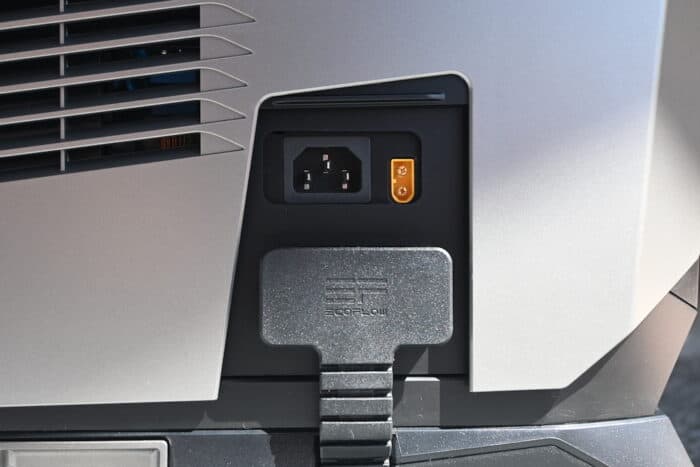
What’s special about the Wave is that it can also be powered via DC, either via the optional Wave Add-on battery or an EcoFlow Delta Max/Delta Pro.
We saw the best efficiency when powering it with DC.
Compressor
It’s a 4,000 BTU air conditioner, so it’s a lot smaller than the typical 13,500 or 15,000 BTU air conditioner found on RVs and vans.
The DC compressor runs very efficiently when paired with either the Delta Max or Delta Pro, and it connects to the power stations via the external battery port.
Fan, AC, Eco Mode
It’s mainly an air conditioner but can also be used in fan mode.
The Eco Mode is a mix of the two and extends the run time of the AC, we will get into this more in our test results.
Control fan speed and temperature
In addition to setting the different modes, you can set the fan speed and temperature either with the rotating dial on the front of the unit or in the phone app.
Just like with the newer EcoFlow solar generators, you can connect your phone both via Bluetooth and WiFi to monitor and control it.
The dial feels very intuitive and the screen is large enough to be readable from a distance.
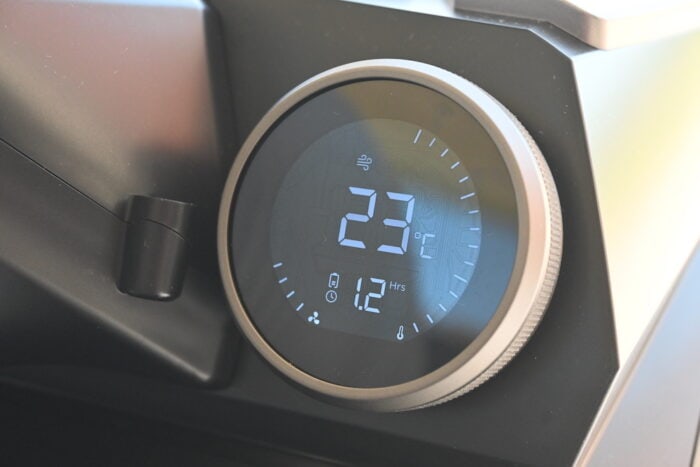
If the Wave Add-on battery is used, the screen will tell how long it’s going to be able to power the Wave with the current settings.
Solar input
Next to the AC and battery ports, there is an XT60 input. This is to be used only when you also have the Wave Add-on battery plugged in to the Wave.
The solar charge controller in the Wave accepts voltages between 11-35V and up to 12A, or 200W.
Since the Add-on battery is a little over 1kWH, you can charge the battery from 0 to 100% in about five hours with solar.
Timer
The timer feature is great for if you plan on leaving the Wave on overnight or during the day while you’re gone.
You can set it to run for a maximum of eight hours. We found it very useful when we only wanted to cool off the room a little bit as we were going to bed.
In the box
The Wave includes a wall charger and I believe it’s supposed to include the car charger as well. EcoFlow has shipped one to us that hasn’t made it here yet.
It also includes two shrouds and two hoses that can be connected to the exhaust/intake and/or the fresh air vent.
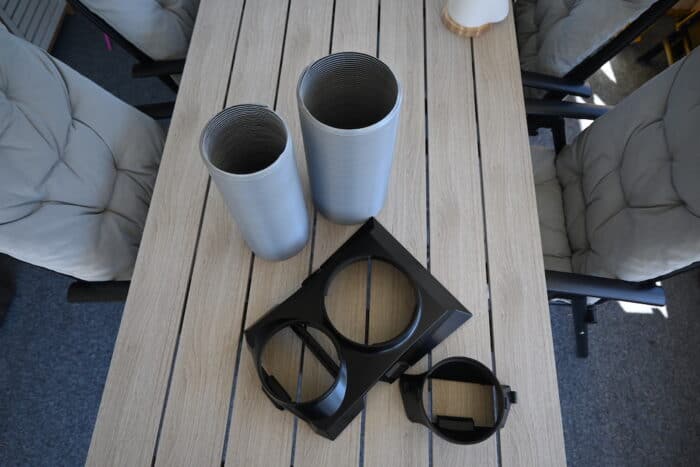
Our Tests
Even though we haven’t tested a portable air conditioner like this before, we knew going in that it’s not meant to cool down a whole house or even a big room.
These are meant to cool down a small bedroom or van, so that’s the kind of setting we have tested the Wave in the most.
Our 13,500 BTU RV AC doesn’t do a great job cooling down our RV since it’s not very insulated and it’s hard to stop heat from getting in, so you can imagine our expectations from a 4,000 BTU portable AC.
Anyhow, let’s get into what we tested and our results.
Power usage
When using the AC plug, I saw it use between 350-550 watts depending on the temperature and how hard the compressor had to work.
When plugged into the external battery port on my Delta Max I didn’t see it go above 400W. Most of the time it was hovering around 320-360W. Note that this requires additional cables.
One thing to remember when it comes to the power usage of an air conditioner is that the compressor isn’t running the whole time, and the power usage will go up and down a lot.
How often the compressor turns on depends on how warm and humid it is in the room.
Cooling down the RV
During a hot summer day, an air conditioner this small is not going to cool down a whole RV, that’s just not possible.
However, the air it shoots out can get very cold and it does a great job even if it’s in a very hot space (upper 80s).
Since the fan is so strong, it can be used for the purpose of cooling down one or more people sitting in front of it.
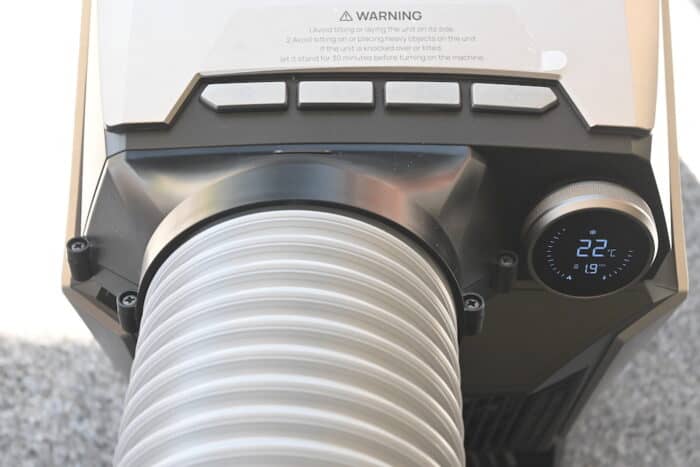
You don’t want to sit too close though, because it will freeze you, but when we put it a couple of feet away and aimed it at our dinette, we could sit and work there all day comfortably.
This worked great both on AC and DC power, and with Eco Mode on we sat for over six hours on a hot day and could focus without overheating.
The downside with our temporary setup was the fact that we had to have a window open for the exhaust hose.
Cooling down the RV bedroom
Our RV is so small that we don’t have a door to the bedroom, but we do have a privacy curtain so we can close it off a bit.
By using the two hoses, one for exhaust and one for the cold air, we were able to set it up in a way so the exhaust went out the window and the cold air into the bedroom.
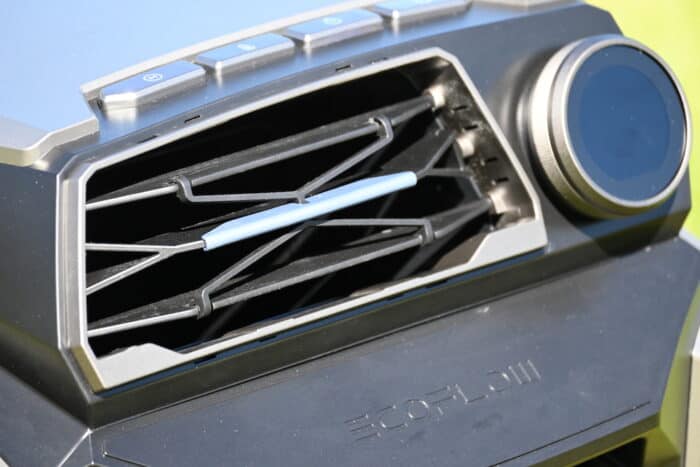
This worked great, and it did a great job. It quickly cooled down the area both during the day when the sun was beating on the windows heating it up, and at night when all it had to do was replace the stale warm air with fresh cool air.
Battery power
How long the battery lasts is going to depend a lot of factors, but you shouldn’t expect it to run for a very long time only using the battery.
We just updated the Wave to its latest firmware and are currently testing how long the battery can power the AC, we’ll update the article when we have test results to share.
What I Like
The efficiency when using DC power
We know that powering a DC appliance with AC power uses more electricity, but the difference still impressed us a lot this time.
It used about 200 watts less on DC versus AC, and with electricity not being cheap these days that matters.
With a Delta Max or Delta Pro hooked up to 500W or more solar panels you could theoretically power the Wave all day long “for free”.
Portable battery
The Wave add-on battery is what makes it possible to power the air conditioner off-grid if you don’t have a solar setup or a power station.
It’s a 1kWh battery which will run the AC for three hours on AC mode, or 7-9 hours on Eco Mode.
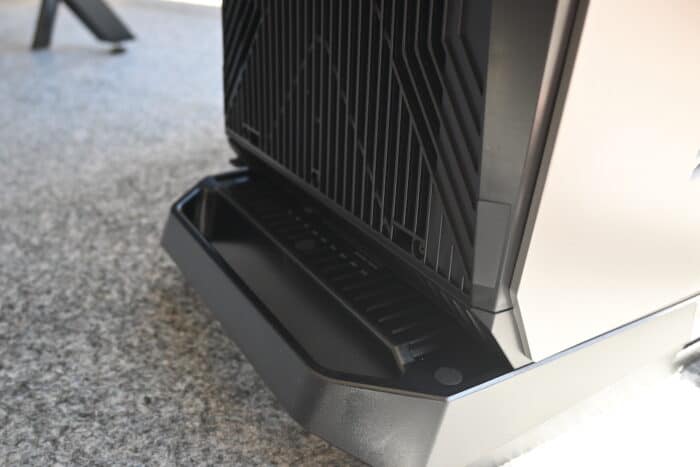
The Wave easily slides on to the top of the battery and latches on. This makes the Wave a lot heavier, so I recommend setting the battery where you plan on using the Wave before connecting it.
WiFi
I already control my power station with the EcoFlow app, so being able to also control the AC remotely is great.
Easy to control
It’s easy to use the phone app, but it’s just as easy to use the controls on the unit itself. Push the button of what you want to control (mode, fan, timer, temperature) then use the dial to set it to what you want.
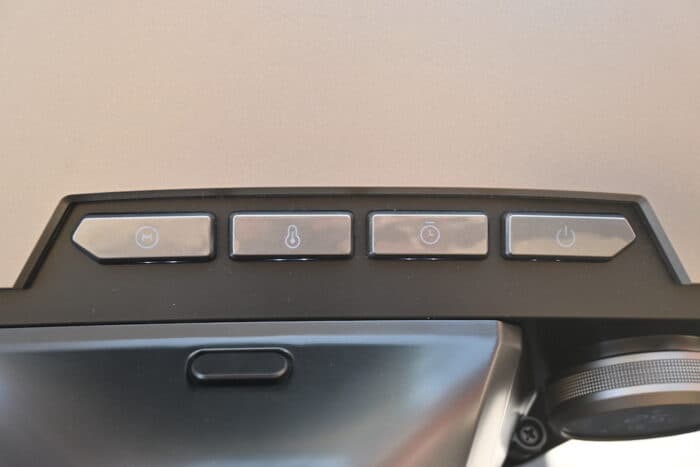
Can be charged with solar
I’m a huge fan of solar powered electronics, and while it’s a bit limited I like that you can connect solar panels directly to the Wave to recharge the optional battery.
No need to drain the water
The Wave comes with a small hose and there is a small plug to connect the hose to to drain water, but that’s only necessary in high humidities.
Otherwise, the water evaporates via the exhaust vent.
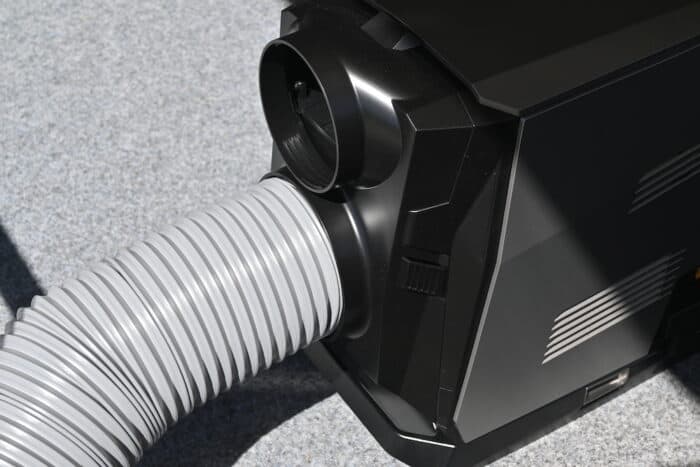
What I Don’t Like
Only 200W solar input & battery must be connected to the Wave
It’s great that you can charge the add-on battery with solar panels, but it maxes out at 200W so it takes at least five hours to charge the battery fully if you max it.
You can also not charge the battery separately, it must be connected to the Wave since the solar charge controller is in the Wave.
DC to DC functionality limited to EcoFlow products
I understand why, but it would’ve been cool to see the DC functionality being compatible with power stations from other brands as well.
Conclusion
The EcoFlow Wave is an interesting product that I hope is the first of many portable air conditioners that support solar charging.
Is it worth the money?
If you have a Delta Max/Pro already being charged by solar panels and you need a portable air conditioner, then yes I think it would be worth it you if you understand its limitations.
If you’re traveling in an RV and hope to use this as your only air conditioner I think you’re going to be disappointed because it simply can’t output enough cold air for that as a 4,000 BTU air conditioner.
It’s a great product if you know what you’re looking for and getting. I wish it would’ve included a battery for the price, but maybe the next model will.
For questions about the Wave, please reach out to EcoFlow. For questions or comments on the review, feel free to comment down below.


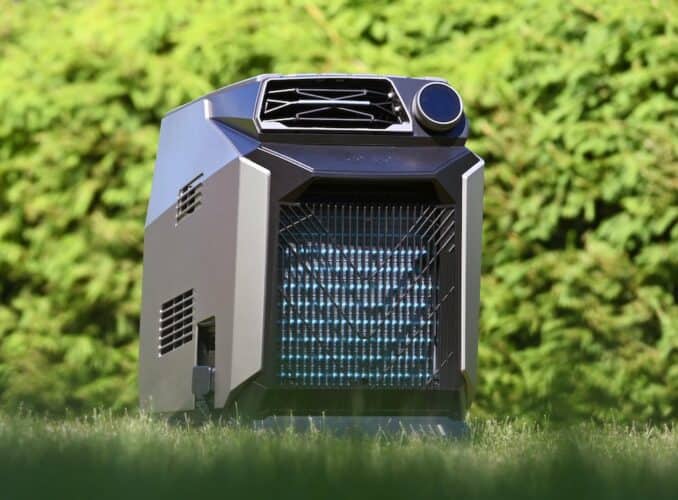
Finally, an honest real-life review. Thank you!